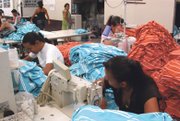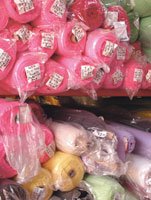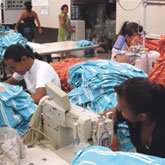Central America's Apparel Industry Hopes to Open New Markets Beyond the U.S.
Under a canopy of bright fluorescent lights that illuminate a giant factory the size of a football field, 1,000 workers put the finishing touches on an array of colorful knit shirts headed mostly for Target stores in the United States.
Merengue and salsa music fill the air as workers bend their heads over whirring sewing machines lined up inside the Genesis Apparel factory.
For years, Target has been the principal customer of this Korean-owned plant, which sits on the outskirts of Guatemala’s capital city. But as General Manager Bong Jong Lee strides across the factory floor, filled with a kaleidoscope of colorful shirts, he stops and points out an anomaly. Folded neatly on a table are piles of gray knit shorts with a Benetton label screen-printed on the outside. When packed, they will be shipped to Italy to fill the store shelves of the Italian chain, which is known for its colorful casualwear.
With apparel production dropping in Central America, Benetton and other European labels may be the salvation needed for the region. Guatemala has been particularly hard hit. A few years ago, the country had 270 apparel factories. Now it has 169. Last year, 11,000 apparel workers lost their jobs.
But because Guatemala’s currency is pegged to the U.S. dollar, whose value has tumbled in recent years compared with the euro, labor costs in this Central American country, just south of Mexico, look extremely attractive to European manufacturers and retailers.
Just two weeks ago, Lee met with top executives from Benetton who said the company is planning to place more orders with factories in Central America, which sends more than 85 percent of its apparel exports to the United States. “We think this is a really good opportunity,” said Lee, noting that many Korean businessmen, who own 60 percent of the clothing factories in Guatemala, had been get t ing ready to bow out in five years. “Now they plan to stay longer,” he said.
Tough times
Central America’s apparel industry has been deeply affected by the faltering U.S. economy. Last year, the Central American countries exported $8.15 billion of apparel to the United States, compared with $8.66 billion in 2006.
In addition, stiff competition from Chinese factories with cheap labor has taken its toll even though the Dominican Republic–Central American Free Trade Agreement has been in effect for two years, giving Central American apparel duty- and quota-free access to the United States.
But as labor costs in China have begun to increase by as much as 20 percent, Central America is starting to look like a bargain-basement deal.
This was evident at the 17th annual Apparel Sourcing Show, held May 13–15 in Guatemala City.
“It’s been a wild ride,” said Gregg Pavalon, president of JeanWorks, based outside of Chicago. His company has a denim factory in Guatemala that two years ago employed 500 people but is now down to 200 workers. However, he expects production to double in Guatemala and a contract factory in Nicaragua this year to 1.2 million units as retailers who want to buy closer to the season opt to produce in Central America.
Apparel producers are also banking on Europe becoming their new frontier. “We see an awakening in Europe toward Central America,” said Carlos Arias, president of Koramsa, the largest blue-jeans maker in Central America. Currently, the company’s principal clients are Abercrombie & Fitch, Kohl’s and Gap Inc., which take up a good share of Koramsa’s production of 250,000 blue jeans a week. But Koramsa recently shipped its first order to Mango, a fast-fashion retail chain based in Spain. Also shipped to Europe was an order to the French retailer Pimkie. “I am hopeful that 25 percent of our business in the next three to five years will come from Europe,” said Arias, whose plant in recent years made as many as 750,000 pairs of blue jeans a week.
That might be possible. Guatemala and other Central American countries are negotiating a free-trade agreement with the European Union.
Rolando Sierra—the new Central American and Caribbean sales manager for Mexico- based GFM Telas Parras, which has three denim factories in that country and a joint-venture denim facility in Italy—said he is noticing companies such as LaCoste, Benetton and Zara are using Central America more for their apparel production. “That is going to bring an opportunity for Mexican mills,” he said, noting that when a special provision of DR-CAFTA goes into effect, Mexico will be able to ship as much as 20 million square meters of denim a year to Central America to make clothing that can return to the United States duty-free. His company is also considering installing a denim mill in Guatemala or some other Central American country to accommodate production.
Scott Quesenberry, the special textile negotiator for the U.S. Trade Representative, spoke at one of the show’s luncheons and said the United States hopes the special provision known as cumulation will be in force by the end of this summer after certain governmental matters are cleared up with the Dominican Republic. Cumulation allows for Mexico to send 45 million square meters of cotton and synthetic bottom weights as well as denim to Central America for input without duties.
Revamping apparel production
One of the problems in Central America, as in other regions, is that input costs for the apparel industry have mushroomed in the last year. That has proved a challenge for apparel and textile manufacturers that are trying to hold down prices at a time when business is flat or dwindling. “It has been a very tough year,” said Alejandro Ceballos, a partner in Polar Industrial, which makes polo shirts and T-shirts as well as fastfood uniforms for the U.S. market. The 11-year-old company has 2,000 employees. “Everything has gone up in price, such as polyester, which is what we use. The price of petroleum has increased. Costs have increased 20 to 25 percent in the last year, but it has hit China harder than us. So things have reverted, and people are coming back,” he said.
To keep costs down, the new Guatemalan government, headed by recently elected Alvaro Colom, has a plan to push apparel production to the rural areas to reduce labor costs. The new president, who started his career in the apparel-production business (at a breakfast at the show, he joked that it was much harder to ship his first container of clothing to the United States than it was getting elected president), is committed to reducing the high cost of electricity in Guatemala by building new plants that will use coal and hydroelectricity instead of fossil fuel. About 60 percent of the country’s electricity is generated by fossil fuels, creating electricity costs that are 2.5 times higher than in the United States.
Also, the new president said he hopes to develop 44 rural townships into apparel-production sites located within freetrade zones. The idea is to find cheaper labor that would be paid on an hourly basis rather than a daily basis as well as employ a population that, in some cases, lives on less than $1 a day.
That sounds like a practical idea, but some are skeptical. Carmen Sowa—the administrative-financial manager for Jerry Leigh, an apparel company headquartered in Van Nuys, Calif., that produces as many as 13 million T-shirts and knit tops a year in Guatemala City—said the idea sounds great but the government will have to improve the roads and highways leading to these far-flung regions before the idea will work. Currently, about 70 percent to 80 percent of the fabric Jerry Leigh uses comes from the United States, much of it from Antex Knitting Mills in Los Angeles. A good road is necessary to get the fabric to the factories.
But Polar Industrial’s Ceballos—who is also the president of Vestex, a trade group representing the Guatemalan apparel and textile industries—is more optimistic. “Guatemala is two countries: those living in the urban area filled with cars and those living in the rural areas dying of hunger,” he said. “These areas would supply cheaper labor for our market, helping us to compete.”

























